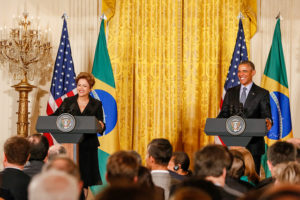Andrés Manuel López Obrador will assume his position as Mexican president on Saturday at a ceremony attended by dozens of heads of state, with the new leader having awakened high expectations of change. It is the first time a leftist candidate has triumphed in Mexico and the campaign that brought him to victory, with more than 53% of the vote, promised major changes in security, economy and energy.
Mexico could become a regional leader in alternative energy and reduce its carbon footprint considerably. AMLO, the acronym by which President López Obrador is known, has pledged to follow this path.
“The new government should continue to work on the agenda of clean energy and sustainability, because they are part of international commitments,” Ana Coll, from Iluméxico, a solar energy developer, told Diálogo Chino.
However, there are obstacles to reaching the goal of producing 35% of electric energy from clean sources by 2024. And despite support for renewable energies, the government continues to prioritise extracting and refining oil.
Mexican energy mix
73.3%
Currently 73.3% of electricity generated in the country depends on fossil fuels (natural gas, oil, coal and diesel). The other 26.7% is produced with alternative sources, mainly from hydroelectric plants, whose contribution to total production is 22%. Wind energy represents 5% and solar energy only 0.1%, according to a study by the Wilson Center Mexico Institute.
Overall, Mexico lags behind the Latin American average, which generates 50% in non-fossil energies.
Despite the low figures, there is a big opportunity to generate energy from alternative sources in remote areas and in the agricultural sector, which currently have little access. There are around three million Mexicans living in 675,000 households without access to electricity in rural areas. Alternative sources are the most viable to reach these areas.
“The government fails to serve these producers,” explained Xunaxi Cruz of Sistema Biobolsa, a company that works with farmers and transforms manure into biogas.
“We do not see them as poor, but as people who have a plan to grow and this aligns with what the government plan says,” says Cruz.
As the second largest economy in Latin America with a growing demand for electricity and untapped energy resources, Mexico is a country full of opportunities for clean energy.
The 2013 energy reform incentivised generation of energy from alternative sources. Inititated by outgoing president Enrique Peña Nieto in 2013 and fully implemented in 2018, the reform broke the monopoly of the state energy company Pemex.
This opened the market for foreign oil companies, but also for the renewable energy sector.
The reform also includes the creation of Clean Energy Certificates (CEC). These stipulate a minimum level of electricity consumption from clean energy sources for all large consumers in Mexico. Participants can trade certificates on the market.
Thanks to these developments, in 2015 Mexico brought in US$4 billion in investment and became one of the 10 most favorable destinations in the world for alternative energies, according to energy secretary Pedro Joaquín Coldwell. Mexico has high potential for investment in solar and wind energy, and as a volcanic country, geothermal.
New government’s stance
AMLO has announced that he will reduce imports of natural gas from the US and will instead increase generation from renewable energy. This will consist of large hydroelectric projects, and from local energy systems that include solar, wind, biomass and geothermal energy.
The new president said he would create incentives through access to credits for local industries to generate renewable energy. He also said that by the time he leaves office in 6 years, he wants to see 100,000 solar-powered electric cars in circulation. These proposals would reduce emissions in Mexico by 6.8 percent annually.
He also proposes to accelerate the clean energy transition by establishing a national network of solar stations and bringing sustainable energies to 45,000 communities that do not have electricity.
Renewable energy companies have to rebuild trust in rural communities following conflicts.
The indigenous leader Bettina Cruz, of the Binni’zaa people, told DW Spanish her community was trampled on by wind energy. In the state of Oaxaca, there are extensive parks with huge bladed towers that generate energy around the clock.
“None of these development projects that have been imposed on us has been for the benefit of the people. On the contrary, there have even been people displaced because of it,” she said.
Many indigenous communities say the projects were installed without a fair consultation process. Though Cruz is sceptical about the new president, AMLO says he will change the way projects affecting indingenous communities are carried out.
At the same time, the new leader claims Mexico’s priority is to get its oil reserves out of the ground.
“The first [objective] is to extract oil and gas urgently, because oil production is falling,” AMLO said at a press conference, adding that he is also looking to reconfigure six existing refineries and build a new one next year.
China’s interest in Mexican energy
China already has oil interests in Mexico. The China National Offshore Oil Corporation (CNOOC) won two major awards in 2016 through which it will invest US$8 billion over the next 35 years.
China also participates in alternative energies. The Chinese company Jinko Solar won the award for two solar power plant projects in the Mexican states of Jalisco and Yucatan that will between them generate 170 megawatts. And China’s Envision Energy International, in consortium with Mexico’s Vive Energía, won the award to develop two wind farms on the Yucatan peninsula.
The technology that China has developed in solar energy in recent years has also had a major impact in Mexico.
“China has driven the manufacture of large-scale solar equipment which has helped to drive down costs dramatically and has made solar energy much cheaper in Mexico,” said Jonah Greenberger, founder of Bright, a solar energy company.
“We use Chinese solar panels exclusively in our projects,” Greenberger added.
China’s solar energy manufacturers account for approximately 60% of the world’s solar cell production, consolidating its status as a global leader in solar manufacturing in 2017, according to a report by the Institute of Energy Economics and Financial Analysis (IEEFA).
Investment in renewable energies is much lower compared to hydrocarbons, with more than US$150 billion in foreign investment.
But technology and investment are not the only sources of support that Mexico could receive from China. In recent years, China has also become the dominant global force in the construction and financing of clean energy technology and Mexico could learn a lesson from this.
Can Mexico learn from China?
Between 2000 and 2015, China’s energy efficiency improved by 30% in industry, both China’s main driver of economic growth and its largest consumer of energy.
State control and government stimuli increased energy efficiency impressively. Chinese measures are closely related to the country’s unique political and government systems. Since the eighties, China started a national program that revolutionized energy, that based on the following measures:
- The government built a system to improve energy efficiency in the industrial sector, the most polluting, which huge gains.
- Government energy saving campaigns were aimed at alleviating energy shortages by planning all aspects, large and small, of energy savings in companies.
- The State established energy efficiency standards, with new companies that could only start working if those standards were met.
- The government also offered substantial subsidies to encourage energy saving measures, reducing economic costs for companies and encouraging the use of energy-saving equipment and technology.
Though the measures are costly and difficult to maintain in the long term, they generated a series of low carbon transformations that have attracted worldwide acclaim.
According to the Wilson Center, Mexico must improve transmission and distribution in energy systems, and reduce the costs of alternative energy by expanding incentives. It should also generate community processes to support new forms of energy.
“Renewable energies are a pillar of this new administration,” said Sofía Alarcón, Mexico director of the Carbon Trust, which is dedicated to reducing emissions.
“The challenge for this new government will be to raise the renewable energy agenda to the same level of oil.”









